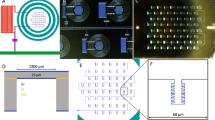Abstract
For astronomical observation at terahertz frequencies, a variety of cryogenic detector technologies are being developed to achieve background-limited observation from space, where a noise equivalent power (NEP) of less than \(10^{-18}\) W/Hz\(^{0.5}\) is often required. When each photon signal is resolved in time, the requirements on NEP are reduced and 1 ns time resolution corresponds to an NEP of approximately \(10^{-17}\) W/Hz\(^{0.5}\) at THz frequencies. Furthermore, fast photon counting detectors have a high dynamic range to observe bright terahertz sources such as stars and active galactic nuclei. Applications of photon counting detector are discussed for cosmic microwave background and photon counting terahertz interferometry.



Similar content being viewed by others
References
B. Swinyard, T. Nakagawa, Exp. Astron. 23, 193 (2009). doi:10.1007/s10686-008-9090-0
W. Wild, N.S. Kardashev, Exp. Astron. 23, 221 (2009). doi:10.1007/s10686-008-9097-6
P.F. Goldsmith et al., Proc. SPIE 7010, 701020 (2008). doi:10.1117/12.788412
D. Leisawitz et al., Adv. Space Res. 40, 689 (2007). doi:10.1016/j.asr.2007.05.081
F. Helmich, R.J. Ivison, Exp. Astron. 23, 245 (2009). doi:10.1007/s10686-008-9100-2
M.G. Hauser et al., Astrophys. J. 508, 25 (1998). doi:10.1086/306379
S. Ariyoshi et al., IEEE Trans. Appl. Supercond. 15–2, 920 (2005). doi:10.1109/TASC.2005.850119
H. Ezawa, H. Matsuo, M. Ukibe, G. Fujii, S. Shiki, J. Low Temp. Phys. This Special Issue (2016)
S. Komiyama, IEEE J. Select. Top. Quantum Electron. 17, 54 (2011). doi:10.1109/JSTQE.2010.2048893
B.S. Karasik, A.V. Sergeev, D.E. Prober, IEEE Trans. Terahertz Sci. Technol. 1, 97 (2011). doi:10.1109/TTHZ.2011.2159560
H. Matsuo, J. Low Temp. Phys. 167, 840 (2012). doi:10.1007/s10909-012-0579-6
P. De Bernardis, S. Masi, Phys. Lett. B 118, 333 (1982). doi:10.1016/0370-2693(82)90197-6
M. Giovannini, Phys. Rev. D 83, 023515 (2011). doi:10.1103/PhysRevD.83.023515
R. Hanbury Brown, R.Q. Twiss, Nature 177, 27 (1956). doi:10.1038/177027a0
H. Ezawa et al., Proc. ISSTT-2015, W2–2 (2015)
Acknowledgments
This research is financially supported by Matsuo Foundation, ISAS/JAXA, and Grant-in-Aid for Exploratory Research of JSPS KAKENHI Grant Number 15K13469.
Author information
Authors and Affiliations
Corresponding author
Rights and permissions
About this article
Cite this article
Matsuo, H., Ezawa, H. Advantages of Photon Counting Detectors for Terahertz Astronomy. J Low Temp Phys 184, 718–723 (2016). https://doi.org/10.1007/s10909-015-1462-z
Received:
Accepted:
Published:
Issue Date:
DOI: https://doi.org/10.1007/s10909-015-1462-z




